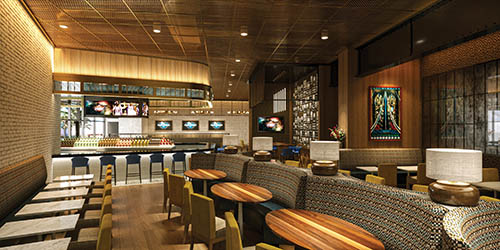— By Rick Marencic —
The rise of the ‘mocktail’ movement and how it impacts restaurant bar design and facility operations.
Consumer awareness of the benefits of low alcohol consumption has increasingly permeated the market — influencing everything from product offerings to how restaurants, bars and entertainment venues are designed. Retail surveys show that sales of non-alcoholic wines, beers and spirits grew from $8 billion in 2018 to over $11 billion in 2022, according to IWSR (International Wine and Spirits Record).
This paradigm shift is largely driven by evolving health priorities. Studies from the U.S. dietary guidelines have signaled a growing awareness, especially among those in the 50+ age group, of alcohol’s impact on metabolism, calorie intake and overall well-being. Additionally, increased recognition of the National Institute of Health (NIH) guidelines for moderate drinking has also swayed buyer decisions.
Interestingly, many customers opting for non-alcoholic beverages are doing so for lifestyle and wellness changes. While they may still consume alcohol in moderation, their preferences increasingly lean toward a hybrid approach, driving the expansion of non-alcoholic options — a bellwether sign of a trend taking hold.
As this demand for high-quality mocktails and alcohol-free options continues to rise, hospitality venues are responding — not just by expanding their beverage menus, but by rethinking the spaces and experiences that bring these drinks to life.
Expanding Product Offerings
The selection of non-alcoholic beverages has grown exponentially since the days of O’Doul’s beer. Distill Ventures is one example of a company that partners with a variety of alcohol-free distillers, vintners and brewers who produce products including Ritual Zero Proof, Seedlip and Kikori Rice Whiskey. These offerings sit alongside familiar brands on many illuminated liquor display shelves and are frequently used to create booze-free cocktails.

Many craft mocktail venues take these beverages to the next level, creating drinks that rival chef-driven culinary experiences. Infused with herbs and plant-based ingredients, including adaptogens like maca, tulsi and ashwagandha, these concoctions offer complex flavors and even a slight natural carbonation, elevating the drinking experience.
A Growing Culture of Alcohol-Free Venues
Alcohol-free venues have sprung in cities like New York; Los Angeles; Austin, Texas; and Denver, forming an early national foundation for the craft mocktail movement. Sans Bar in Austin proudly claims its status as the first non-alcoholic bar in North America, offering a mocktail school and academy. In Los Angeles, patrons can savor their preferred mocktails at Droplet, Optimist Botanicals and De Soi.
Even prominent regional casinos are embracing the movement. At the newly opened Desert Diamond White Tanks Casino in western Phoenix, Seedlip is prominently featured on the Pub-Stop back bar, positioned adjacent to top shelf liquor choices.
How the Mocktail Trend is Shaping Bar Design
For the interior designer, the variety of ingredients used to craft the latest mocktails influences the design and functionality of the bar. Bartenders are no longer just mixing drinks; they transform into actors who cut, slice, dice, blend and assemble a collage of organic ingredients in a theater of mixology. The curtain is pulled to reveal an elaborate set, the bar as stage, activity framed, customer facing, a proscenium, like the open kitchen concept that captivated us in the 1990s. To support this, refrigerated storage of fresh ingredients, fruits, herbs and vegetables is essential, with prep surfaces and tools easily accessible for the bartender’s craft.
The bar-as-stage concept extends to multiple points of sale, visually designed to promote health and wellness. This could include an attractive arrangement of farm-to-table ingredients, similar to how raw seafood, meats or vegetables are displayed to entice restaurant goers. The stage requires state-of-the-art lighting for actors, props and the set. Key areas are framed and positioned within the space to create prominent sightlines. It’s the theater of design, where the interior designer’s skillset shapes the space to align with the client’s vision.
The storyline behind each mocktail is a play. The playwright conveys the provenance of the characters and the skill of the mixologist at work — crafting unique offerings that inspire on multiple levels. The experience may be heightened with live video feeds of the process or fresh market ingredients being sustainably harvested. It’s a sensory journey that invites customers to take home not just a drink, but a lasting memory of the fresh alternative milieu that the mocktail brings to our contemporary lifestyle.
The Future of the Mocktail Movement
For restaurateurs, bar operators and designers alike, the mocktail movement presents an opportunity to create immersive, consumer-focused experiences that cater to evolving preferences. What started as a niche wellness-driven movement has evolved into a lasting shift in buyer behavior, influencing everything from product innovation to interior design. n
— Rick Marencic, IIDA, NCIDQ is principal and studio leader of JCJ Architecture. His experience in interior design spans more than 30 years and includes all phases of design, from initial concept and documentation to construction administration and project closeout. For more information, visit www.jcj.com.

